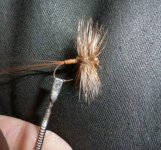Generally speaking, parachutes, comparaduns, and CDC type flies float lower. Body in water.
Catskill ties sit higher and tend to move and "dance" a bit on the water (unassociated with drag).
I use all of the above. Which is better? Depends on the fish that day.
This is just a theory, but I tend to believe the lower sitting "modern" flies work better when fish are taking emergers. The higher floating ones work better when fish are taking duns, and they seem to key on movement.
Back in the old days, I think there was more of a tendency to use catskill ties as dun imitations, as well as emerger patterns for emergers. In more modern times, the popularity of the low sitting dries has increased and represents a more "jack of all trades" approach. i.e. a comparadun or parachute works ok for both duns and emergers most of the time. But if you get really picky fish maybe you'd be better off with the emerger/catskill choice.





